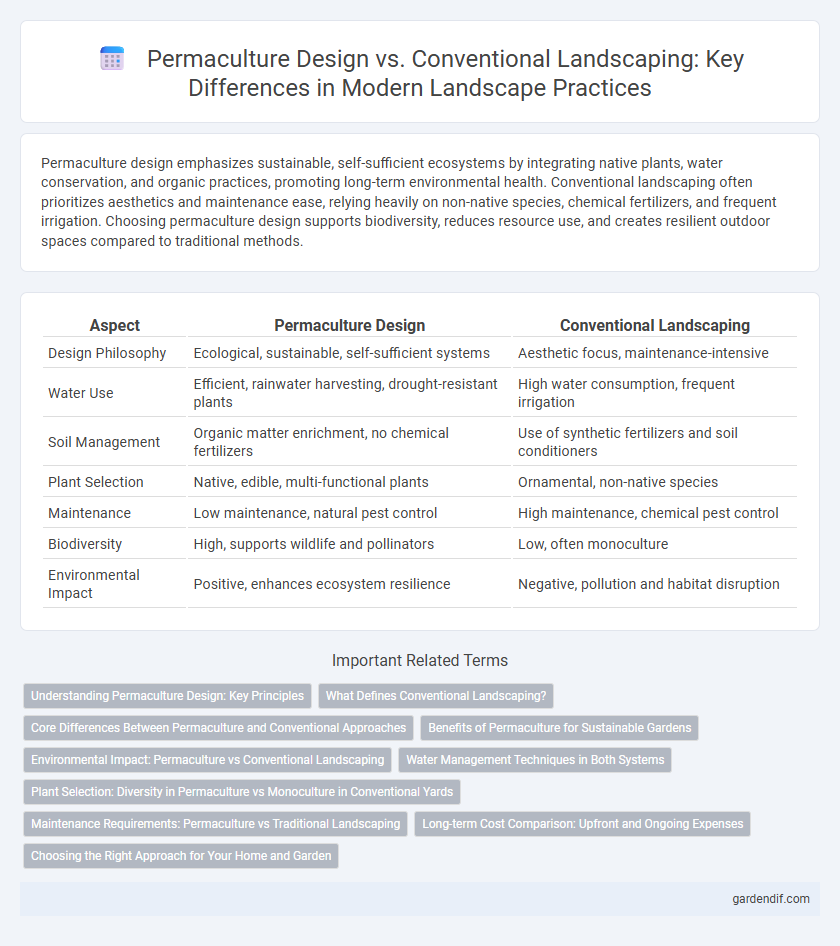
Permaculture Design vs Conventional Landscaping Illustration
Permaculture design emphasizes sustainable, self-sufficient ecosystems by integrating native plants, water conservation, and organic practices, promoting long-term environmental health. Conventional landscaping often prioritizes aesthetics and maintenance ease, relying heavily on non-native species, chemical fertilizers, and frequent irrigation. Choosing permaculture design supports biodiversity, reduces resource use, and creates resilient outdoor spaces compared to traditional methods.
Table of Comparison
| Aspect | Permaculture Design | Conventional Landscaping |
|---|---|---|
| Design Philosophy | Ecological, sustainable, self-sufficient systems | Aesthetic focus, maintenance-intensive |
| Water Use | Efficient, rainwater harvesting, drought-resistant plants | High water consumption, frequent irrigation |
| Soil Management | Organic matter enrichment, no chemical fertilizers | Use of synthetic fertilizers and soil conditioners |
| Plant Selection | Native, edible, multi-functional plants | Ornamental, non-native species |
| Maintenance | Low maintenance, natural pest control | High maintenance, chemical pest control |
| Biodiversity | High, supports wildlife and pollinators | Low, often monoculture |
| Environmental Impact | Positive, enhances ecosystem resilience | Negative, pollution and habitat disruption |
Understanding Permaculture Design: Key Principles
Permaculture design emphasizes sustainable land use by integrating natural ecosystems with human environments, focusing on principles such as care for the earth, care for people, and fair share of resources. It prioritizes biodiversity, water conservation, soil regeneration, and energy efficiency, contrasting sharply with conventional landscaping that often relies on high-maintenance lawns and chemical inputs. Key elements include creating self-sustaining systems through natural patterns and renewable resources, which promote long-term environmental resilience and reduced ecological impact.
What Defines Conventional Landscaping?
Conventional landscaping typically involves the use of non-native plants, synthetic fertilizers, and chemical pesticides to create manicured lawns and ornamental gardens prioritizing aesthetics over ecological function. These landscapes often require high water usage, frequent maintenance, and diminish biodiversity by favoring turfgrass monocultures and non-native species. Conventional landscaping focuses on creating visually appealing but resource-intensive environments with limited consideration for sustainability or ecosystem health.
Core Differences Between Permaculture and Conventional Approaches
Permaculture design emphasizes sustainable, self-sufficient ecosystems by integrating native plants, water conservation, and soil health, promoting biodiversity and long-term resilience. Conventional landscaping often prioritizes aesthetic appeal and low initial cost, relying heavily on non-native species, synthetic fertilizers, and regular maintenance. Core differences lie in permaculture's holistic, regenerative methods versus conventional landscaping's typically short-term, resource-intensive practices.
Benefits of Permaculture for Sustainable Gardens
Permaculture design enhances soil health, conserves water, and promotes biodiversity through its holistic, nature-inspired principles, unlike conventional landscaping that often relies on synthetic inputs and monoculture. Sustainable gardens designed with permaculture reduce maintenance costs and environmental impact by integrating native plants, natural pest control, and efficient resource use. This approach creates resilient ecosystems that support pollinators, improve air quality, and capture carbon, contributing to long-term ecological balance.
Environmental Impact: Permaculture vs Conventional Landscaping
Permaculture design enhances biodiversity, conserves water through rainwater harvesting, and reduces soil erosion by mimicking natural ecosystems, resulting in a significantly lower environmental footprint compared to conventional landscaping. Conventional landscaping often relies heavily on synthetic fertilizers, pesticides, and extensive water use, which contribute to soil degradation, water pollution, and loss of native species. By integrating native plants and ecological principles, permaculture promotes sustainable land management that supports long-term ecosystem health and climate resilience.
Water Management Techniques in Both Systems
Permaculture design prioritizes water conservation through techniques such as swales, rain gardens, and mulching, which work to capture and retain rainwater, enhance soil moisture, and reduce runoff. Conventional landscaping often relies on irrigation systems and drainage infrastructure that may increase water consumption and contribute to runoff and erosion. Incorporating permaculture water management strategies promotes sustainable water use, improves ecosystem health, and reduces the environmental impact compared to traditional landscaping methods.
Plant Selection: Diversity in Permaculture vs Monoculture in Conventional Yards
Permaculture design emphasizes diverse plant selection to create resilient ecosystems, incorporating native species, perennials, and companion planting to improve soil health and support wildlife. Conventional landscaping often favors monoculture with limited species variety, prioritizing aesthetics over ecological balance and relying heavily on chemical inputs. This diversity in permaculture enhances sustainability, reduces pest outbreaks, and promotes long-term soil fertility compared to the uniformity seen in traditional yards.
Maintenance Requirements: Permaculture vs Traditional Landscaping
Permaculture design emphasizes low-maintenance landscapes by creating self-sustaining ecosystems that reduce water use, soil erosion, and weed growth through natural plant diversity and organic mulching. In contrast, conventional landscaping often requires intensive upkeep, including frequent mowing, irrigation, fertilization, and pesticide application to maintain uniform lawns and ornamental plants. The sustainable practices in permaculture minimize long-term labor and resource inputs, making it a more eco-friendly and cost-effective approach to landscape maintenance.
Long-term Cost Comparison: Upfront and Ongoing Expenses
Permaculture design typically requires a higher upfront investment due to the integration of diverse plant species, soil enhancement, and water management systems but results in significantly lower ongoing expenses through reduced need for fertilizers, pesticides, and irrigation. Conventional landscaping often involves lower initial costs with standard turf and ornamental plants but incurs higher recurring expenses from frequent maintenance, chemical inputs, and water usage. Over time, permaculture's sustainable practices promote cost savings and environmental benefits, making it economically advantageous compared to conventional landscaping.
Choosing the Right Approach for Your Home and Garden
Permaculture design emphasizes sustainable, self-sufficient ecosystems by integrating native plants, organic soil management, and water conservation techniques, promoting biodiversity and long-term resilience. Conventional landscaping often prioritizes aesthetic appeal and low upfront costs, using non-native plants and chemical inputs that may require ongoing maintenance. Selecting the right approach depends on your environmental goals, maintenance capacity, and desire for ecological balance versus immediate visual impact.
Permaculture Design vs Conventional Landscaping Infographic

 gardendif.com
gardendif.com